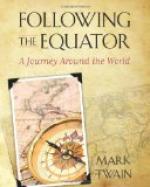We sailed in the afternoon late, spent a few hours at New Plymouth, then sailed again and reached Auckland the next day, November 20th, and remained in that fine city several days. Its situation is commanding, and the sea-view is superb. There are charming drives all about, and by courtesy of friends we had opportunity to enjoy them. From the grassy crater-summit of Mount Eden one’s eye ranges over a grand sweep and variety of scenery—forests clothed in luxuriant foliage, rolling green fields, conflagrations of flowers, receding and dimming stretches of green plain, broken by lofty and symmetrical old craters—then the blue bays twinkling and sparkling away into the dreamy distances where the mountains loom spiritual in their veils of haze.
It is from Auckland that one goes to Rotorua, the region of the renowned hot lakes and geysers—one of the chief wonders of New Zealand; but I was not well enough to make the trip. The government has a sanitorium there, and everything is comfortable for the tourist and the invalid. The government’s official physician is almost over-cautious in his estimates of the efficacy of the baths, when he is talking about rheumatism, gout, paralysis, and such things; but when he is talking about the effectiveness of the waters in eradicating the whisky-habit, he seems to have no reserves. The baths will cure the drinking-habit no matter how chronic it is—and cure it so effectually that even the desire to drink intoxicants will come no more. There should be a rush from Europe and America to that place; and when the victims of alcoholism find out what they can get by going there, the rush will begin.
The Thermal-springs District of New Zealand comprises an area of upwards of 600,000 acres, or close on 1,000 square miles. Rotorua is the favorite place. It is the center of a rich field of lake and mountain scenery; from Rotorua as a base the pleasure-seeker makes excursions. The crowd of sick people is great, and growing. Rotorua is the Carlsbad of Australasia.
It is from Auckland that the Kauri gum is shipped. For a long time now about 8,000 tons of it have been brought into the town per year. It is worth about $300 per ton, unassorted; assorted, the finest grades are worth about $1,000. It goes to America, chiefly. It is in lumps, and is hard and smooth, and looks like amber—the light-colored like new amber, and the dark brown like rich old amber. And it has the pleasant feel of amber, too. Some of the light-colored samples were a tolerably fair counterfeit of uncut South African diamonds, they were so perfectly smooth and polished and transparent. It is manufactured into varnish; a varnish which answers for copal varnish and is cheaper.
The gum is dug up out of the ground; it has been there for ages. It is the sap of the Kauri tree. Dr. Campbell of Auckland told me he sent a cargo of it to England fifty years ago, but nothing came of the venture. Nobody knew what to do with it; so it was sold at 15 a ton, to light fires with.




